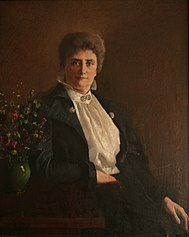Gina Krog
Krog wrote articles and gave speeches, travelling throughout Europe and North America to attend international women's rights conferences.
Krog was strongly inspired by the American liberal women's rights movement spearheaded by Susan B. Anthony and Elizabeth Cady Stanton.
Krog was regarded as an unapologetic liberal progressive during her time, seeking full and equal voting rights for all women on the same conditions as men.
As a young adult, she worked as a teacher in private schools for several years, continuing to improve her knowledge of languages and literature through self-study.
[4] She travelled to Great Britain, where she stayed at Bedford College[1] and made contacts within the National Union of Women's Suffrage Societies, including its leader Millicent Garrett Fawcett.
[1] In her arguments, Krog emphasized the common human qualities shared by men and women, reasoning that anyone who paid taxes and accepted civic responsibilities should receive the same freedoms and political status.
Although some suffragists preferred to focus on gender differences, claiming women had special feminine qualities that made them deserving of the vote, Krog avoided using this rhetoric.
When Berner drafted the association's mission statement, he declared a neutral purpose of aiming "to provide the woman with her right and place in society".
[7] Krog, however, wanted the association to pursue equal voting rights for men and women, and her position brought her into direct conflict with Berner.
[9] She had been inspired by reading The History of Woman Suffrage, a set of historical volumes sent by American women's rights activist Susan B.
During the 1890s, however, many liberal politicians had withdrawn from the cause, expressing fears that women with the vote would naturally gravitate towards supporting conservative candidates.
Krog remained firm in her belief that women must fight for complete voting rights "on the same conditions as men", regardless of class.
[13] Krog accepted responsibility for creating a Norwegian branch of the International Council of Women, and began making plans.
[7] The branch was notably active the following year, when the Storting held a national vote on the dissolution of the union between Norway and Sweden.
[5] Krog was part of the official Norwegian delegate sent to Amsterdam for the Fourth Conference of the International Woman Suffrage Alliance in 1908.
[7] That same year, Krog's fellow activist Anna Rogstad was elected a deputy MP, becoming the first female member of the Storting.
[1] A bronze bust of Krog, sculpted by Ambrosia Tønnesen in 1919, is located at her grave at Vår Frelsers gravlund in Oslo.
[3] In March 2013, the Norwegian Ministry of Petroleum and Energy announced that the Dagny oil field would be renamed Gina Krog in her honour.




